DIPLOMA IN EARLY CHILDHOOD EDUCATION AND CARE Assignment Solution
VerifiedAdded on 2020/04/01
|8
|1478
|337
Homework Assignment
AI Summary
This assignment solution addresses key concepts in Early Childhood Education and Care, starting with a differentiation between disruptive behavior and behavior of concern, along with indicators of the latter. It explores observation methods for collecting behavioral information and examines the impact of conditions like Autism Spectrum Disorder (ASD) and environmental factors like noise and overcrowding on child behavior. The assignment emphasizes the importance of understanding a child's culture, monitoring behavior, and using strategies to redirect and defuse situations. Part B assesses understanding of ethical codes, conventions related to child development, and frameworks like the National Quality Standard and Early Years Learning Framework. It discusses the impact of disruptions on learning and development, the importance of stimulating environments, and the influence of biological and environmental factors. The solution concludes with descriptions of Lev Vygotsky's and Maria Montessori's theories of child development, along with references.

Running Head: DIPLOMA IN EARLY CHILDHOOD EDUCATION AND CARE 1
DIPLOMA IN EARLY CHILDHOOD EDUCATION AND CARE
Name
University
Course
Tutor
Date
DIPLOMA IN EARLY CHILDHOOD EDUCATION AND CARE
Name
University
Course
Tutor
Date
Paraphrase This Document
Need a fresh take? Get an instant paraphrase of this document with our AI Paraphraser
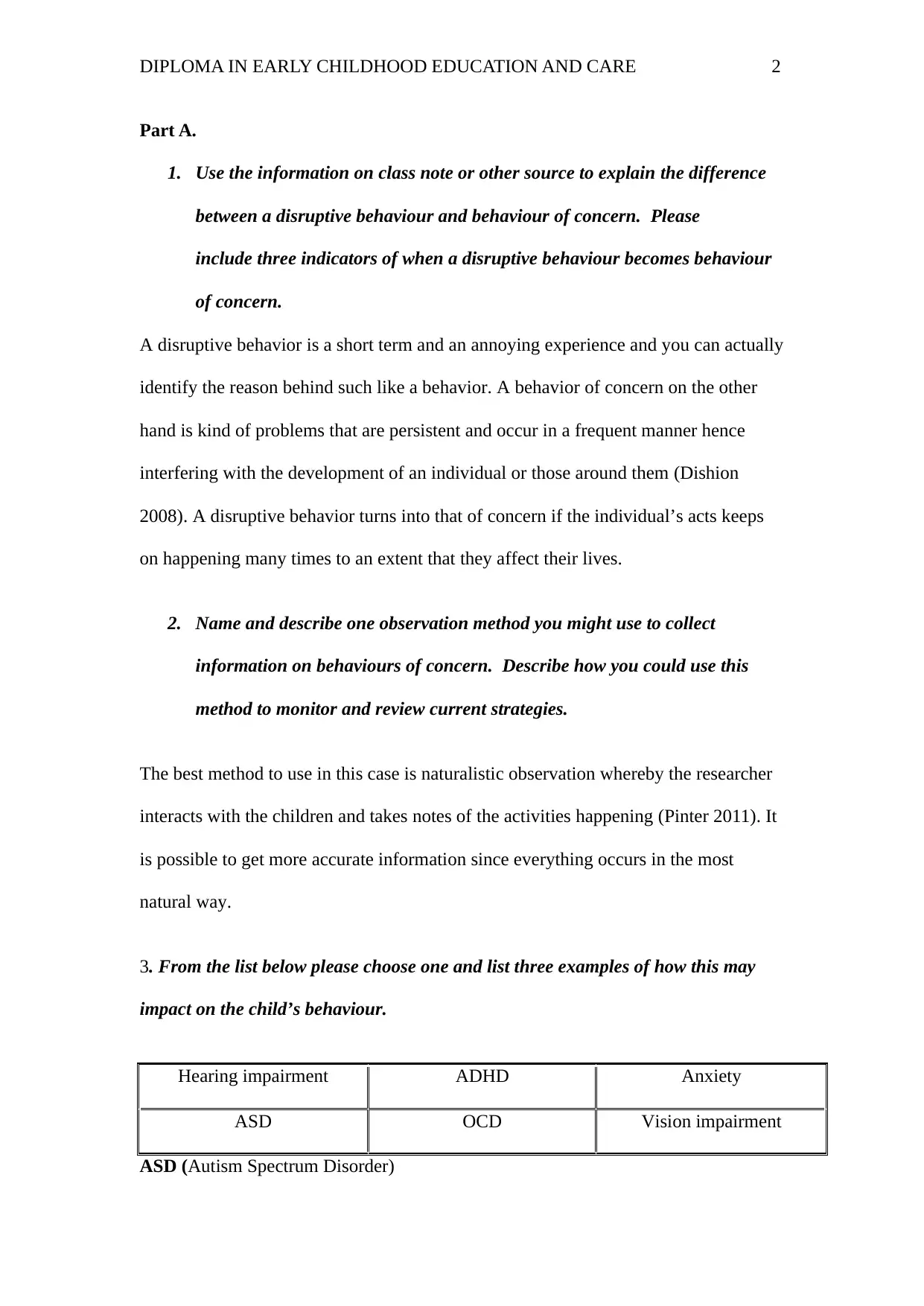
DIPLOMA IN EARLY CHILDHOOD EDUCATION AND CARE 2
Part A.
1. Use the information on class note or other source to explain the difference
between a disruptive behaviour and behaviour of concern. Please
include three indicators of when a disruptive behaviour becomes behaviour
of concern.
A disruptive behavior is a short term and an annoying experience and you can actually
identify the reason behind such like a behavior. A behavior of concern on the other
hand is kind of problems that are persistent and occur in a frequent manner hence
interfering with the development of an individual or those around them (Dishion
2008). A disruptive behavior turns into that of concern if the individual’s acts keeps
on happening many times to an extent that they affect their lives.
2. Name and describe one observation method you might use to collect
information on behaviours of concern. Describe how you could use this
method to monitor and review current strategies.
The best method to use in this case is naturalistic observation whereby the researcher
interacts with the children and takes notes of the activities happening (Pinter 2011). It
is possible to get more accurate information since everything occurs in the most
natural way.
3. From the list below please choose one and list three examples of how this may
impact on the child’s behaviour.
Hearing impairment ADHD Anxiety
ASD OCD Vision impairment
ASD (Autism Spectrum Disorder)
Part A.
1. Use the information on class note or other source to explain the difference
between a disruptive behaviour and behaviour of concern. Please
include three indicators of when a disruptive behaviour becomes behaviour
of concern.
A disruptive behavior is a short term and an annoying experience and you can actually
identify the reason behind such like a behavior. A behavior of concern on the other
hand is kind of problems that are persistent and occur in a frequent manner hence
interfering with the development of an individual or those around them (Dishion
2008). A disruptive behavior turns into that of concern if the individual’s acts keeps
on happening many times to an extent that they affect their lives.
2. Name and describe one observation method you might use to collect
information on behaviours of concern. Describe how you could use this
method to monitor and review current strategies.
The best method to use in this case is naturalistic observation whereby the researcher
interacts with the children and takes notes of the activities happening (Pinter 2011). It
is possible to get more accurate information since everything occurs in the most
natural way.
3. From the list below please choose one and list three examples of how this may
impact on the child’s behaviour.
Hearing impairment ADHD Anxiety
ASD OCD Vision impairment
ASD (Autism Spectrum Disorder)
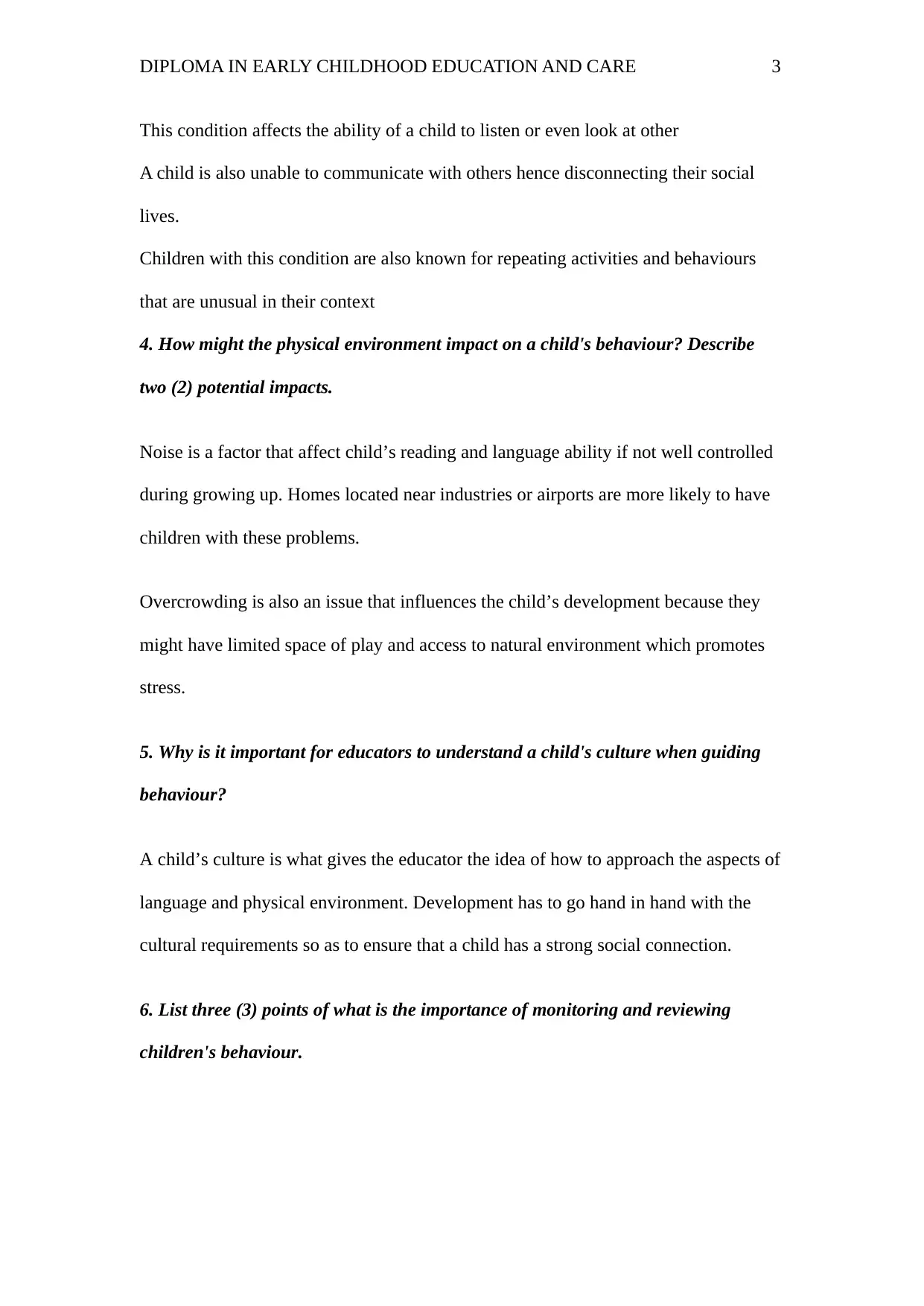
DIPLOMA IN EARLY CHILDHOOD EDUCATION AND CARE 3
This condition affects the ability of a child to listen or even look at other
A child is also unable to communicate with others hence disconnecting their social
lives.
Children with this condition are also known for repeating activities and behaviours
that are unusual in their context
4. How might the physical environment impact on a child's behaviour? Describe
two (2) potential impacts.
Noise is a factor that affect child’s reading and language ability if not well controlled
during growing up. Homes located near industries or airports are more likely to have
children with these problems.
Overcrowding is also an issue that influences the child’s development because they
might have limited space of play and access to natural environment which promotes
stress.
5. Why is it important for educators to understand a child's culture when guiding
behaviour?
A child’s culture is what gives the educator the idea of how to approach the aspects of
language and physical environment. Development has to go hand in hand with the
cultural requirements so as to ensure that a child has a strong social connection.
6. List three (3) points of what is the importance of monitoring and reviewing
children's behaviour.
This condition affects the ability of a child to listen or even look at other
A child is also unable to communicate with others hence disconnecting their social
lives.
Children with this condition are also known for repeating activities and behaviours
that are unusual in their context
4. How might the physical environment impact on a child's behaviour? Describe
two (2) potential impacts.
Noise is a factor that affect child’s reading and language ability if not well controlled
during growing up. Homes located near industries or airports are more likely to have
children with these problems.
Overcrowding is also an issue that influences the child’s development because they
might have limited space of play and access to natural environment which promotes
stress.
5. Why is it important for educators to understand a child's culture when guiding
behaviour?
A child’s culture is what gives the educator the idea of how to approach the aspects of
language and physical environment. Development has to go hand in hand with the
cultural requirements so as to ensure that a child has a strong social connection.
6. List three (3) points of what is the importance of monitoring and reviewing
children's behaviour.
⊘ This is a preview!⊘
Do you want full access?
Subscribe today to unlock all pages.

Trusted by 1+ million students worldwide
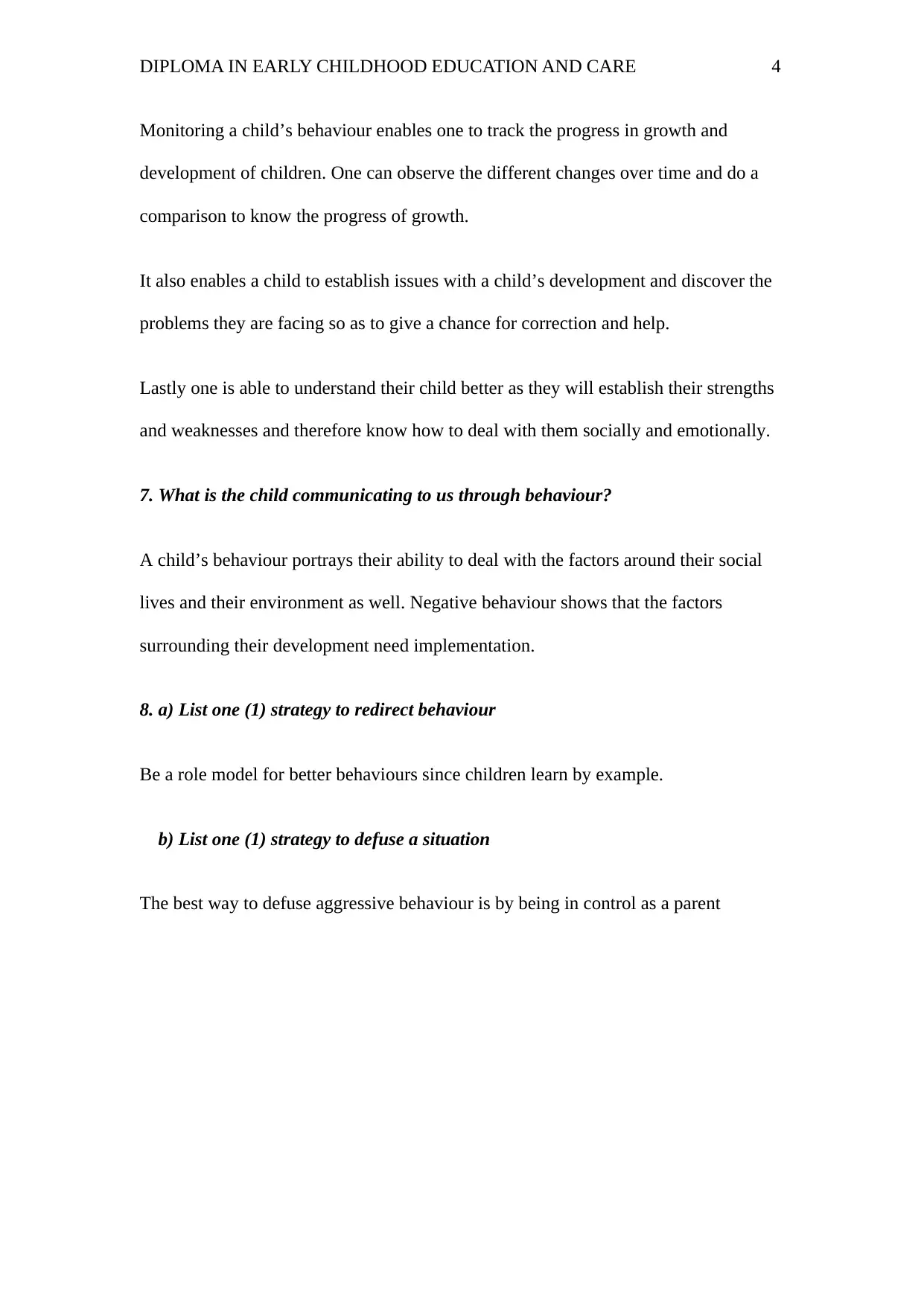
DIPLOMA IN EARLY CHILDHOOD EDUCATION AND CARE 4
Monitoring a child’s behaviour enables one to track the progress in growth and
development of children. One can observe the different changes over time and do a
comparison to know the progress of growth.
It also enables a child to establish issues with a child’s development and discover the
problems they are facing so as to give a chance for correction and help.
Lastly one is able to understand their child better as they will establish their strengths
and weaknesses and therefore know how to deal with them socially and emotionally.
7. What is the child communicating to us through behaviour?
A child’s behaviour portrays their ability to deal with the factors around their social
lives and their environment as well. Negative behaviour shows that the factors
surrounding their development need implementation.
8. a) List one (1) strategy to redirect behaviour
Be a role model for better behaviours since children learn by example.
b) List one (1) strategy to defuse a situation
The best way to defuse aggressive behaviour is by being in control as a parent
Monitoring a child’s behaviour enables one to track the progress in growth and
development of children. One can observe the different changes over time and do a
comparison to know the progress of growth.
It also enables a child to establish issues with a child’s development and discover the
problems they are facing so as to give a chance for correction and help.
Lastly one is able to understand their child better as they will establish their strengths
and weaknesses and therefore know how to deal with them socially and emotionally.
7. What is the child communicating to us through behaviour?
A child’s behaviour portrays their ability to deal with the factors around their social
lives and their environment as well. Negative behaviour shows that the factors
surrounding their development need implementation.
8. a) List one (1) strategy to redirect behaviour
Be a role model for better behaviours since children learn by example.
b) List one (1) strategy to defuse a situation
The best way to defuse aggressive behaviour is by being in control as a parent
Paraphrase This Document
Need a fresh take? Get an instant paraphrase of this document with our AI Paraphraser
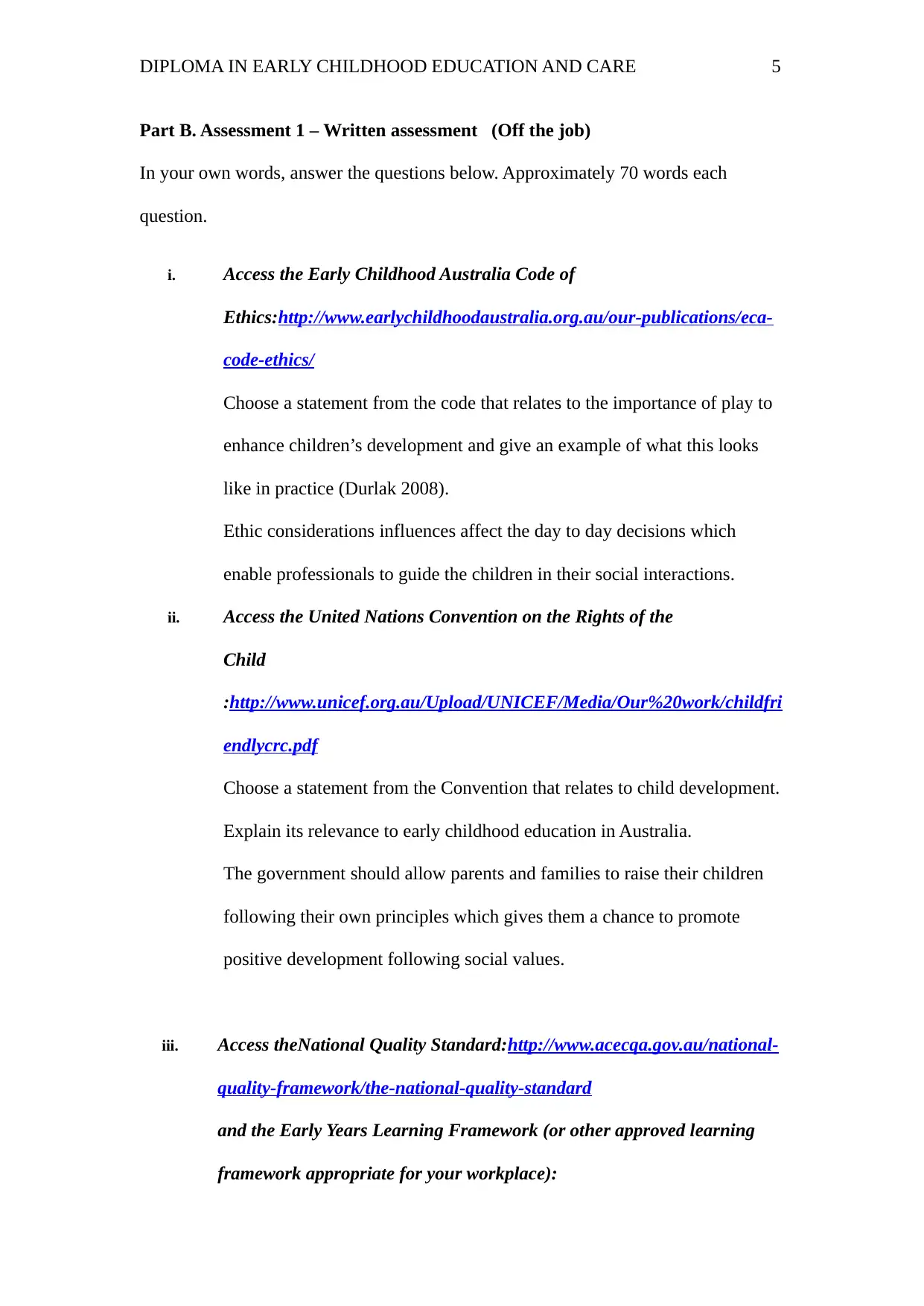
DIPLOMA IN EARLY CHILDHOOD EDUCATION AND CARE 5
Part B. Assessment 1 – Written assessment (Off the job)
In your own words, answer the questions below. Approximately 70 words each
question.
i. Access the Early Childhood Australia Code of
Ethics:http://www.earlychildhoodaustralia.org.au/our-publications/eca-
code-ethics/
Choose a statement from the code that relates to the importance of play to
enhance children’s development and give an example of what this looks
like in practice (Durlak 2008).
Ethic considerations influences affect the day to day decisions which
enable professionals to guide the children in their social interactions.
ii. Access the United Nations Convention on the Rights of the
Child
:http://www.unicef.org.au/Upload/UNICEF/Media/Our%20work/childfri
endlycrc.pdf
Choose a statement from the Convention that relates to child development.
Explain its relevance to early childhood education in Australia.
The government should allow parents and families to raise their children
following their own principles which gives them a chance to promote
positive development following social values.
iii. Access theNational Quality Standard:http://www.acecqa.gov.au/national-
quality-framework/the-national-quality-standard
and the Early Years Learning Framework (or other approved learning
framework appropriate for your workplace):
Part B. Assessment 1 – Written assessment (Off the job)
In your own words, answer the questions below. Approximately 70 words each
question.
i. Access the Early Childhood Australia Code of
Ethics:http://www.earlychildhoodaustralia.org.au/our-publications/eca-
code-ethics/
Choose a statement from the code that relates to the importance of play to
enhance children’s development and give an example of what this looks
like in practice (Durlak 2008).
Ethic considerations influences affect the day to day decisions which
enable professionals to guide the children in their social interactions.
ii. Access the United Nations Convention on the Rights of the
Child
:http://www.unicef.org.au/Upload/UNICEF/Media/Our%20work/childfri
endlycrc.pdf
Choose a statement from the Convention that relates to child development.
Explain its relevance to early childhood education in Australia.
The government should allow parents and families to raise their children
following their own principles which gives them a chance to promote
positive development following social values.
iii. Access theNational Quality Standard:http://www.acecqa.gov.au/national-
quality-framework/the-national-quality-standard
and the Early Years Learning Framework (or other approved learning
framework appropriate for your workplace):
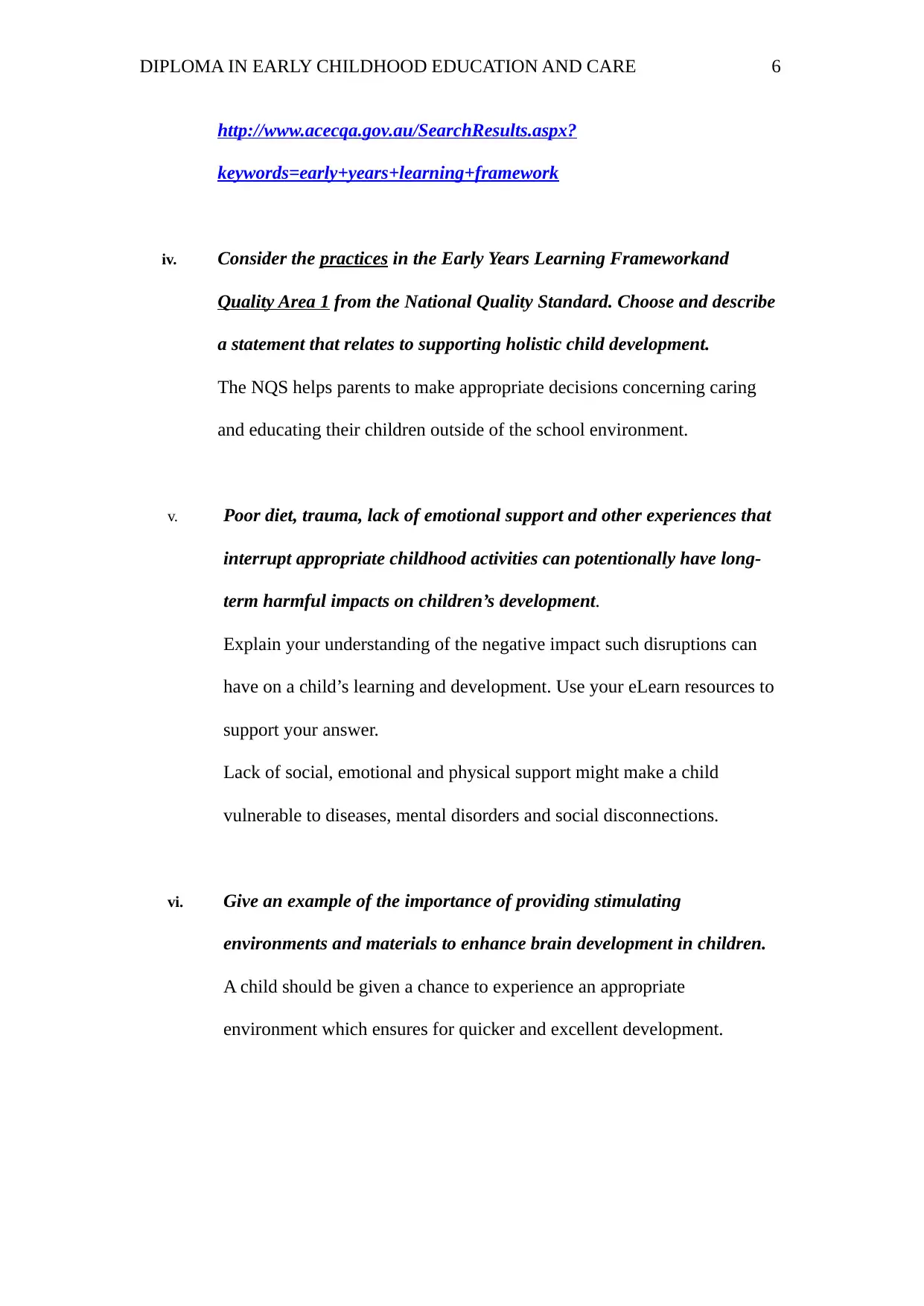
DIPLOMA IN EARLY CHILDHOOD EDUCATION AND CARE 6
http://www.acecqa.gov.au/SearchResults.aspx?
keywords=early+years+learning+framework
iv. Consider the practices in the Early Years Learning Frameworkand
Quality Area 1 from the National Quality Standard. Choose and describe
a statement that relates to supporting holistic child development.
The NQS helps parents to make appropriate decisions concerning caring
and educating their children outside of the school environment.
v. Poor diet, trauma, lack of emotional support and other experiences that
interrupt appropriate childhood activities can potentionally have long-
term harmful impacts on children’s development.
Explain your understanding of the negative impact such disruptions can
have on a child’s learning and development. Use your eLearn resources to
support your answer.
Lack of social, emotional and physical support might make a child
vulnerable to diseases, mental disorders and social disconnections.
vi. Give an example of the importance of providing stimulating
environments and materials to enhance brain development in children.
A child should be given a chance to experience an appropriate
environment which ensures for quicker and excellent development.
http://www.acecqa.gov.au/SearchResults.aspx?
keywords=early+years+learning+framework
iv. Consider the practices in the Early Years Learning Frameworkand
Quality Area 1 from the National Quality Standard. Choose and describe
a statement that relates to supporting holistic child development.
The NQS helps parents to make appropriate decisions concerning caring
and educating their children outside of the school environment.
v. Poor diet, trauma, lack of emotional support and other experiences that
interrupt appropriate childhood activities can potentionally have long-
term harmful impacts on children’s development.
Explain your understanding of the negative impact such disruptions can
have on a child’s learning and development. Use your eLearn resources to
support your answer.
Lack of social, emotional and physical support might make a child
vulnerable to diseases, mental disorders and social disconnections.
vi. Give an example of the importance of providing stimulating
environments and materials to enhance brain development in children.
A child should be given a chance to experience an appropriate
environment which ensures for quicker and excellent development.
⊘ This is a preview!⊘
Do you want full access?
Subscribe today to unlock all pages.

Trusted by 1+ million students worldwide

DIPLOMA IN EARLY CHILDHOOD EDUCATION AND CARE 7
vii. Nature (biological factors) and nurture (environmental factors) both
influence development. Describe what each is, and give an example of
how it can affect development.
Biological factors traces back to the family history in such a way that a
child with genetic development issues might be vulnerable (Cicchetti
2006). Environmental factors involve the physical weather whereby
children who get access to natural environment have a better chance of
growth and positive development.
viii. Choose two of the theorists listed below. Briefly describe their theories of
child development. Write approximate 120 words. provide a reference list.
Lev Vygotsy, 1934-1896
The theory states that social interactions play a major role in the cognition
development.
Maria Montessori, 1870-1952
The theory explains the importance of observing a child’s development including
social, cognitive and emotional since birth. Montessori emphasises more on the
learning process of children and the important aspects that must be considered.
Children learn more appropriately if the environment around them supports their
ability to gain knowledge and skills. Parents, relatives and teachers should therefore
give their best to ensure that the cognitive skills of a child are well addressed. It is
important to provide a harmonious environment for learning and hence achieve a
natural process that requires less efforts and time. Children are naturally curious of
learning new things and therefore if given the appropriate external support, then it
vii. Nature (biological factors) and nurture (environmental factors) both
influence development. Describe what each is, and give an example of
how it can affect development.
Biological factors traces back to the family history in such a way that a
child with genetic development issues might be vulnerable (Cicchetti
2006). Environmental factors involve the physical weather whereby
children who get access to natural environment have a better chance of
growth and positive development.
viii. Choose two of the theorists listed below. Briefly describe their theories of
child development. Write approximate 120 words. provide a reference list.
Lev Vygotsy, 1934-1896
The theory states that social interactions play a major role in the cognition
development.
Maria Montessori, 1870-1952
The theory explains the importance of observing a child’s development including
social, cognitive and emotional since birth. Montessori emphasises more on the
learning process of children and the important aspects that must be considered.
Children learn more appropriately if the environment around them supports their
ability to gain knowledge and skills. Parents, relatives and teachers should therefore
give their best to ensure that the cognitive skills of a child are well addressed. It is
important to provide a harmonious environment for learning and hence achieve a
natural process that requires less efforts and time. Children are naturally curious of
learning new things and therefore if given the appropriate external support, then it
Paraphrase This Document
Need a fresh take? Get an instant paraphrase of this document with our AI Paraphraser
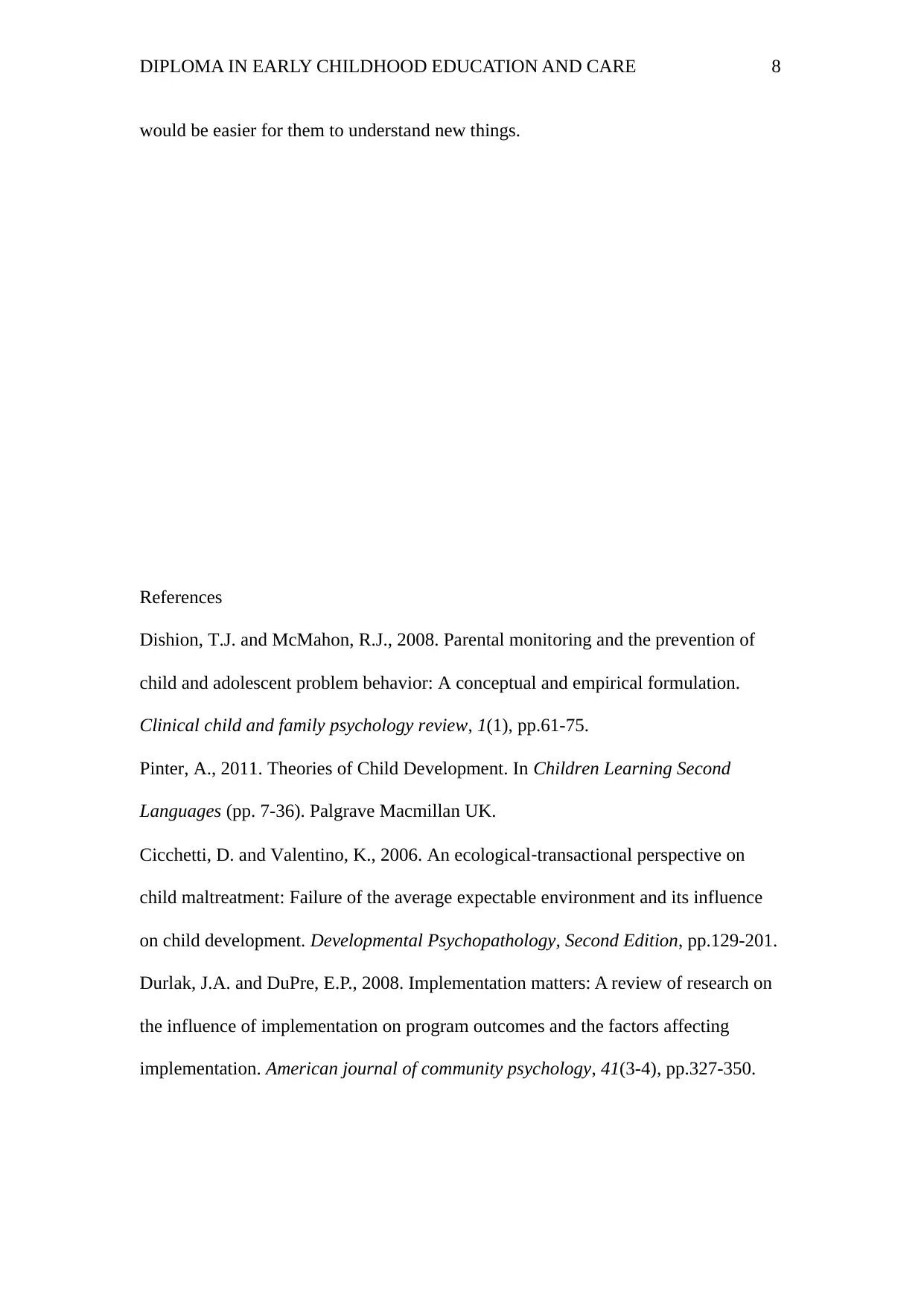
DIPLOMA IN EARLY CHILDHOOD EDUCATION AND CARE 8
would be easier for them to understand new things.
References
Dishion, T.J. and McMahon, R.J., 2008. Parental monitoring and the prevention of
child and adolescent problem behavior: A conceptual and empirical formulation.
Clinical child and family psychology review, 1(1), pp.61-75.
Pinter, A., 2011. Theories of Child Development. In Children Learning Second
Languages (pp. 7-36). Palgrave Macmillan UK.
Cicchetti, D. and Valentino, K., 2006. An ecological‐transactional perspective on
child maltreatment: Failure of the average expectable environment and its influence
on child development. Developmental Psychopathology, Second Edition, pp.129-201.
Durlak, J.A. and DuPre, E.P., 2008. Implementation matters: A review of research on
the influence of implementation on program outcomes and the factors affecting
implementation. American journal of community psychology, 41(3-4), pp.327-350.
would be easier for them to understand new things.
References
Dishion, T.J. and McMahon, R.J., 2008. Parental monitoring and the prevention of
child and adolescent problem behavior: A conceptual and empirical formulation.
Clinical child and family psychology review, 1(1), pp.61-75.
Pinter, A., 2011. Theories of Child Development. In Children Learning Second
Languages (pp. 7-36). Palgrave Macmillan UK.
Cicchetti, D. and Valentino, K., 2006. An ecological‐transactional perspective on
child maltreatment: Failure of the average expectable environment and its influence
on child development. Developmental Psychopathology, Second Edition, pp.129-201.
Durlak, J.A. and DuPre, E.P., 2008. Implementation matters: A review of research on
the influence of implementation on program outcomes and the factors affecting
implementation. American journal of community psychology, 41(3-4), pp.327-350.
1 out of 8
Related Documents
Your All-in-One AI-Powered Toolkit for Academic Success.
+13062052269
info@desklib.com
Available 24*7 on WhatsApp / Email
![[object Object]](/_next/static/media/star-bottom.7253800d.svg)
Unlock your academic potential
Copyright © 2020–2025 A2Z Services. All Rights Reserved. Developed and managed by ZUCOL.



